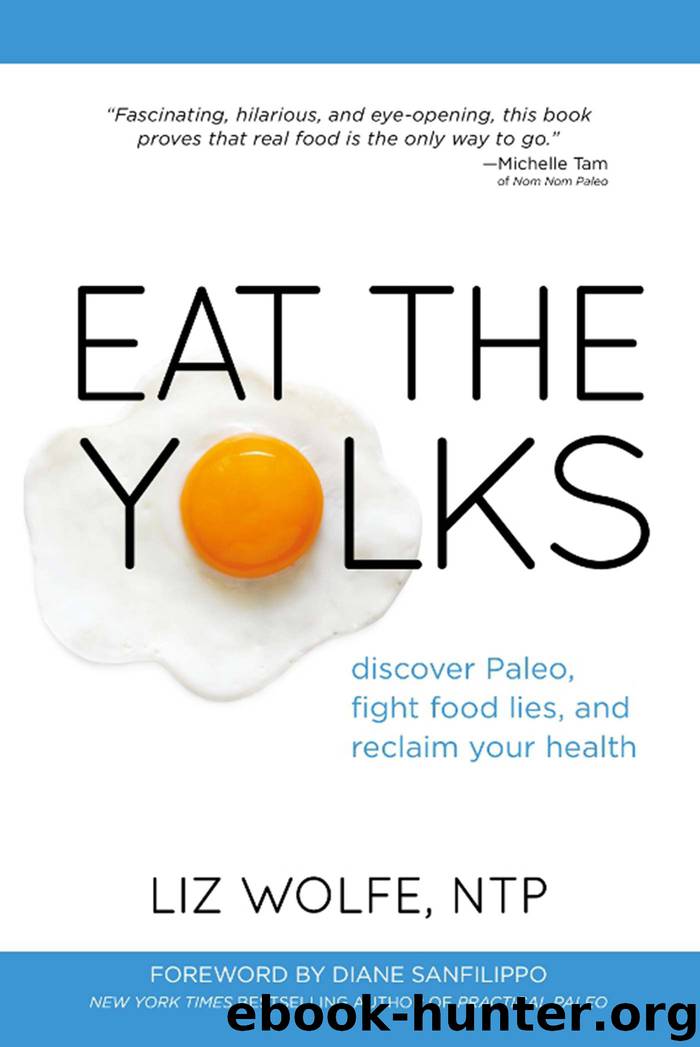Eat the Yolks: Discover Paleo, fight food lies, and reclaim your health by Wolfe Liz

Author:Wolfe, Liz [Wolfe, Liz]
Language: eng
Format: epub, pdf
Publisher: Victory Belt Publishing
Published: 2014-02-23T00:00:00+00:00
The chemistry of carbs
In the words of Inigo Montoya, “Let me ’splain. No. There is too much. Let me sum up.”
It may take me a few thousand words, but I’ll “sum up” as best I can.
To this point, I’ve spoken about Earth-damaging crops, the tricks of carb marketing, the low-down dirty agricultural industry, and why we’re so attached to carb-rich foods, especially carbage. That’s important background information, and I’m all about context. Now, though, it’s time to get down to brass tacks: what carbs are at the fundamental level, how our bodies use them, what exactly makes a carb-rich food good or bad, and all the other ins and outs of carbohydrates in our modern diets.
In the strictest sense, carbs are chemical structures, just like fat and protein. These chemical structures are composed of carbon, hydrogen, and oxygen, and they play starring roles in our food. There’s plenty of merit in understanding those structures. That’s science, and some perverts find that science is fun.
Let’s expand on that. Let’s expand on it like my waistline on funnel cakes.
In order to burn carbohydrates, the body must first break those carbs free of the foods they’re in, and then break them down again, converting them into glucose. Glucose is the most basic carbohydrate possible—a monosaccharide—and the one and only form of carbohydrate our cells can use. Once the breaking-down process is complete, glucose enters the bloodstream. Depending on how much glucose hits our bloodstream at a given moment, we may feel totally normal, or we may feel a blood-sugar spike followed by a sudden crash, a sign that our personal carb intake or something else in our diet, like the level of healthy fat or protein, needs tweaking. A rise in blood sugar stimulates the pancreas to release insulin. Insulin shuttles the glucose to the cells, where it’s used in the generation of energy.
This sounds simple. It’s not.
Carbohydrates, with the exception of fiber, are all destined to be delivered to the bloodstream as glucose. Despite their shared destiny, however, not all carbs are the same. The effect of carbs on blood sugar depends on the food they’re in. Some carbs, like those from sugars and syrups, require very little digestion and are absorbed quickly, hitting the bloodstream fast and hard. Others, like those within sweet potatoes, hit the bloodstream more slowly and steadily thanks to the amount of time a sweet potato takes to work its way through the digestive system. This keeps blood sugar on a more even keel.
While glucose is the monosaccharide that our cells can use, you may have heard of a couple others: galactose, which is found in lactose, a milk sugar; and fructose, the sweetest of all natural sugars, which is found in nature within fruits and honey and in the laboratory within the manufactured sweetener high-fructose corn syrup. Both galactose and fructose must be converted to glucose by the liver before being released to the bloodstream—an extra step in the process that is unique to those monosaccharides.
While
Download
Eat the Yolks: Discover Paleo, fight food lies, and reclaim your health by Wolfe Liz.pdf
This site does not store any files on its server. We only index and link to content provided by other sites. Please contact the content providers to delete copyright contents if any and email us, we'll remove relevant links or contents immediately.
How to Be a Bawse: A Guide to Conquering Life by Lilly Singh(7162)
Deep Work by Cal Newport(6587)
The Longevity Diet by Valter Longo(4864)
The Fat Loss Plan by Joe Wicks(4629)
The Four-Pack Revolution by Chael Sonnen & Ryan Parsons(3797)
The Ultimate Bodybuilding Cookbook by Kendall Lou Schmidt(3713)
The French Women Don't Get Fat Cookbook by Mireille Guiliano(3423)
Super Food Family Classics by Jamie Oliver(3251)
Not a Diet Book by James Smith(3156)
Turn Up Your Fat Burn! by Alyssa Shaffer(3064)
Factfulness_Ten Reasons We're Wrong About the World_and Why Things Are Better Than You Think by Hans Rosling(3053)
Self-Esteem by Matthew McKay & Patrick Fanning(2960)
Tom Kerridge's Dopamine Diet: My low-carb, stay-happy way to lose weight by Kerridge Tom(2956)
Body Love by Kelly LeVeque(2909)
The Unbecoming of Mara Dyer by Michelle Hodkin(2869)
The Fat Chance Cookbook by Robert H. Lustig(2645)
Tone Your Tummy Type by Denise Austin(2639)
LL Cool J's Platinum 360 Diet and Lifestyle by LL Cool J(2588)
Men's Health Best by Men's Health Magazine(2398)
